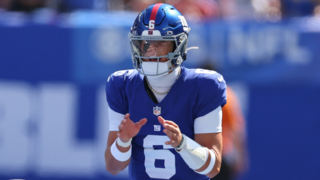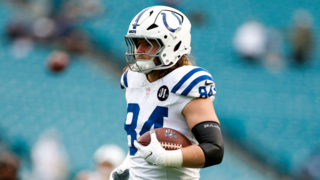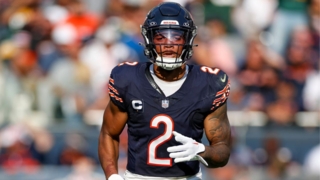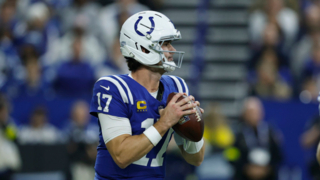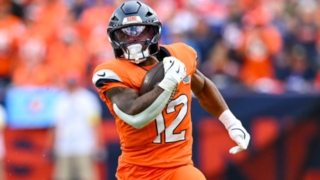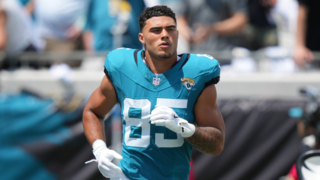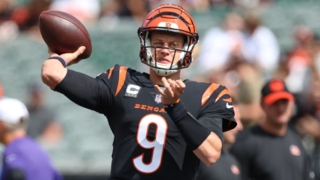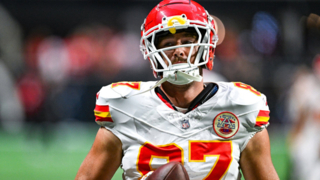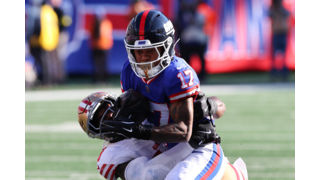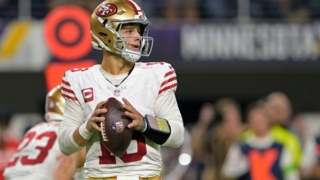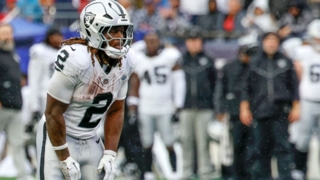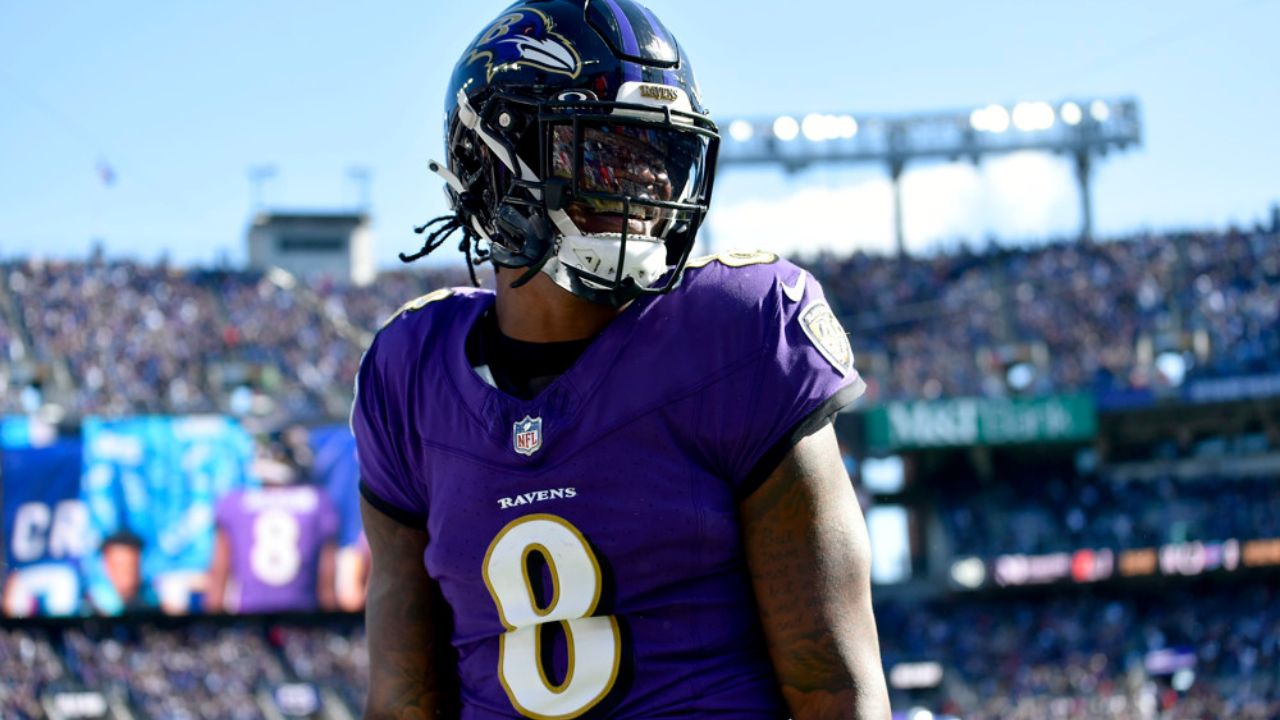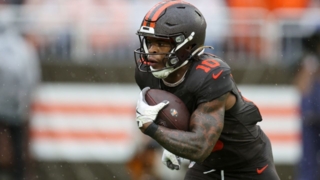What We Got Right in 2024 Can Help You Win in 2025

Jayden Daniels & More Defined 2024 Success
I don’t know about you, but I’m probably gonna be a Jayden Daniels fan forever.
The Commanders QB delivered the fifth-most fantasy points at the position as a 2024 rookie. He also posted the fifth-most fantasy points per game of any rookie QB ever. And he did so with good – not crazy, outlandish, unrepeatable – numbers as both a passer and a rusher.
The reason I enjoyed it so much, of course, is because Daniels’ terrific rookie campaign came after we named him our Breakout Player for 2024.
Why Did Jayden Daniels Work?
I previously highlighted some of the key players we got wrong for fantasy football in 2024. Now Daniels kicks off the other side.
But just like in that previous article, we’re not so much focused on the what. It’s the why that can actually help us going forward.
So why did we like Daniels so much? Three main factors:
- The displayed rushing ability
- The displayed deep-passing ability
- The ADP
Daniels’ big-time college rushing production and supporting speed set a high fantasy floor in his first starting season. His strong passing production at LSU – especially with the deep ball – raised the ceiling. And even late in August, the rookie still sat just 12th among QBs in redraft ADP.
Daniels was basically a more proven, more polished version of Anthony Richardson – yet going several rounds after the Colts QB. And we saw top-6 upside on the rookie.
If you’re not drafting an already-elite fantasy QB, then that’s a type you want to target. And Daniels played even better than hoped he would.
Daniels Landed on Lots of DS Rosters
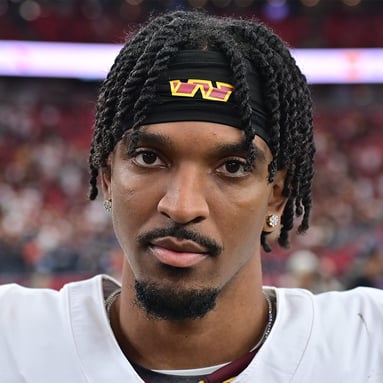
Given his “breakout player” status for us in summer 2024, it’s not surprising that Daniels finished the season on more of your synced rosters than any other QB.
In fact, we collected end-of-season data from all rosters connected with DraftSharks.com’s league sync, and Daniels was the seventh most rostered player overall – one of just three QBs at 12% or higher.
That suggests our Draft War Room consistently recommended Daniels and the next two QBs as part of your draft-day strategy. And the QB trio worked out pretty well.
What Else We Got Right at QB
At a one-starter position – such as QB in most fantasy football leagues – when you draft your QB can be at least as important as having the options ranked appropriately.
A difference of one or two rankings spots might not seem like much, for example. But it could be enough to make the Draft War Room consistently ignore a QB1 target the market’s overrating (C.J. Stroud in 2024) and highlight someone our numbers favor more …
Jalen Hurts and Joe Burrow
Burrow and Eagles QB Jalen Hurts joined Daniels among the three most rostered QBs on season-ending DS rosters in 2024.

Hurts’ season ended unfortunately for fantasy managers, as he left Week 16 early and then missed Week 17 with a concussion. But he otherwise posted the position’s fourth-best scoring average, improving on his 2023 per-game scoring average and edging Josh Allen in that category (as we projected).
Burrow was a bigger hit, though.

He climbed from a QB7 August ADP to No. 2 for the year in fantasy points per game. Just like with Daniels, that upside was key.
How to Draft Your QB
You can fit your QB selection around the rest of your draft plan – and be flexible vs. the way your draft plays out.
You can target an elite QB early, but you’ll want consistent high-level production (Hurts).
If you wait beyond that level, look for a guy going at least a little later than he should – with upside to challenge the top of the position (Burrow).
Daniels fit that category as well, while adding the crucial factor of rushing production – an aspect fantasy drafters remain capable of underrating.
The common thread through these three QBs is upside. That’s why we give every player a ceiling projection. And it’s why your Draft War Room features Upside Mode.
We’ll hit that point a little more in the TE section below …
There's Much More Than Just Upside Mode
What We Got Right at RB
Those upside calculations obviously come into play at RB as well, and they played a key role in the most rostered player across season-ending DS-user rosters …
De’Von Achane, Miami Dolphins

If I had to guess at who that most-rostered player would be, I’m not sure how many tries I’d need to get to Achane.
I don’t remember being especially high on the Dolphin myself. But that’s kinda the point of our process.
Do the projections. Apply the league settings. Let the Draft War Room highlight the value.
And then you get Achane springing from a RB11 preseason ADP to a RB5 finish in total PPR points – even with a four-game, no-Tua lull early in the season.
What Went Right
Achane carries some key upside signals into the season:
- Talent (duh)
- Unclear work distribution, which helped keep his ADP controlled
- Shallow offense
Miami entered last season with Tyreek Hill as the incumbent stud, Jaylen Waddle as the upside No. 2, and little other proven receiving production.
TE Jonnu Smith emerged after signing a decent-sized free agent contract. But there also proved to be room for Achane to gobble up targets and receiving production. And that followed offseason and preseason buzz that Miami planned to throw Achane the ball more.
When high-end talent meets intriguing opportunity at a modest market price, it’s good to look past the uncertainty (workload distribution) and buy the upside.
James Conner and Joe Mixon
I’m combining these two RBs because we got them right for basically the same reason.
The draft market prefers youth. And it loves to find reasons not to draft Conner and Mixon.
Let the Market Remove the Risk
Sure, our historical aging data says that targeting an RB in his age-29 season isn’t generally a great idea. We’ve traditionally seen significant drops in production at the position in that season.
But sometimes the sharper draft market can get too smart for its own good.

Drafting Conner among the top 12 RBs last summer would have made him pretty risky – even though he finished each of the previous three years in that range in fantasy points per game.
But drop that guy to RB18 in ADP, and he’s an upside play.
That draft price builds in the risk that then-rookie Trey Benson takes some work. It accounts for some potential drop-off in Conner’s performance. It even accounts for the injury risk we know is there and factor in.
When ADP bakes in all that risk for you, then you can look best it and bet on a player who showed no preseason signals of ceding his backfield lead. If you did so with Conner, you got a guy who finished 15th in PPR points per game – despite leaving two games early – and delivered 20+ fantasy points in weeks 14, 15, and 16.
Mixon an Even Easier Bet

When our projections hit the site each season, there are few things you can count on more than DS liking Mixon better than the market does. And it has paid off much more than it has hurt.
Some had concerns last summer that Mixon’s rushing style wouldn’t ideally fit Houston’s scheme. And his advanced metrics signaled the RB’s fantasy production got some help from Cincinnati’s high-powered offense.
But the Texans clearly committed financially to Mixon leading the backfield. Dameon Pierce entered the year as No. 2, a season after he fell clearly behind Devin Singletary.
Houston told us with the Mixon trade and contract extension that it believed him to be a big upgrade over Singletary. But the market left Mixon just 15th among RBs in ADP.
That’s another example of the market removing the risk for you and unintentionally highlighting the upside.
Any Similar Targets for 2025?
It’s early, and a potentially loaded class of rookie RBs could shake up many a backfield. But Mixon and Conner once again highlight a value range at RB in current best ball ADP.

Chiefs RB Isiah Pacheco – RB25 in Underdog Fantasy ADP right now – has been a favorite target of mine in early best ball drafting as well.
What We Got Right at WR
The first WR on our list lines up with what we got right about Achane …
Malik Nabers, New York Giants

Just like everyone else, we didn’t have Nabers projected higher than classmate Marvin Harrison Jr. healing into last season. We certainly had concerns about the potential negative impact of QB Daniel Jones and the Giants’ offense in general.
But Harrison was going around the 1-2 turn in drafts, so we highlighted him as one of the biggest potential busts for the year. (More on Harrison in a minute.)
Nabers, meanwhile, wound up as the fourth most rostered player by DS users.
What Went Right for Nabers
Part of that was certainly his ceiling projection combined with ADP. Another factor might have been our multiple calls to try to buy Nabers during the season.
Why? From Week 2 on, the Giants made it clear they were going to force-feed him targets. And when you get a talented player gobbling opportunity volume, you chase that over worrying about his surroundings.
Nabers wound up sixth in total PPR points, eighth in PPR points per game and atop the entire league in target share.
Look for Underrated Target Opportunity
Few WRs match Nabers’ talent. But you’ll be able to find guys every year whose target-share upside is underrated.
That looks like a primary driver for players who show up as strong best ball values at WR by our ADP Market Index.
Raiders WR Jakobi Meyers has ranked among my favorite early targets for just that reason.
Tee Higgins, Cincinnati Bengals

There’s a little room for controversy with this one … which is part of why I went ahead and included Higgins here.
If you drafted Higgins in 2024, then you probably hated him before September ended and someone woke up Green Day.
The WR missed the season’s first two games. Then came a sluggish Week 3 debut (3 catches, 39 yards). Plus another three games lost to injury in the middle of the year.
But even with those five missed games, Higgins racked up the 17th-most PPR points at the position – easily outperforming his WR28 ADP. On a per-game basis, he ranked sixth at the position.
‘Yeah, but the Injuries Screwed Me’
Fair enough. If you draft a guy to start and he’s not even on the field to open the season, then you’ve got an extra challenge.
But … we did warn you of that challenge with our Injury Guide. No WR carried a higher “probability of injury” than Higgins …

Well then why should I bother drafting him?
For those numbers he posted when on the field.
Sometimes that high-level injury risk will be reason to skip drafting a guy altogether – but only when the risk outweighs the upside.
First- or second-round pick on the guy most likely to get hurt across the position? Shaky bet. But if you can get that guy in mid-WR3 territory, with top-12 per-game upside – take a shot.
We’ll help you insure around him.
Learn More About How Our Injury Predictor Works
Marvin Harrison Jr., Arizona Cardinals

I’m highlighting most of the guys in this article for how they helped our rosters. In this case, though, not drafting Harrison was how we helped ourselves.
We presented the Cardinals rookie as one of the top “bust” picks of 2024. And his journey from WR9 in ADP to WR44 in PPR points per game justified that selection.
What Didn’t We Like About Harrison?
Like I mentioned earlier, the most important difference between Harrison and Nabers – as well as other 2024 rookie WRs – was where you needed to draft the Cardinal.
He was leaving the board ninth among WRs on average, around the 1-2 turn in 12-team, PPR drafting.
That starting point left no room for error with Harrison. He needed to have an all-time great rookie season to pay off from there.
If you need an outlier performance for a player to pay off his draft price, then you’re almost always better off going against that guy.
What’s That Mean for 2025 and Beyond?
Let me start by re-emphasizing that we didn’t dislike Harrison the player. The case against him was all about his market valuation.
That’s why Malik Nabers landed on a lot more DS teams (lower price). And those market valuations were also what made Brian Thomas Jr. and Ladd McConkey such strong factors in 2024.
All four rookie WRs entered the season with more questions than answers. But you didn’t have to invest nearly as much to take shots on Nabers, Thomas, or McConkey as you did with Harrison.
Keep that factor in mind as you decide who to chase and pass on in your drafts going forward.
What We Got Right at Tight End
Not gonna lie … we did pretty well at this position in 2024. And like at QB, it came down more to when to draft your TE than it did vast differences in the rankings.
With that in mind, I’m grouping three key guys together rather than hitting them individually.
David Njoku, Brock Bowers, and Sam LaPorta
Let’s start with what we got “right” regarding each guy …

Njoku and Bowers closed the season as the two most rostered TEs by DS users. Bowers, of course, led all TEs in PPR points while narrowly trailing George Kittle for the lead in points per game.

Njoku navigated six games lost to injuries and ranked fourth in PPR points per game, after entering the year 10th at the position in ADP.
We got LaPorta right in the other direction, by projecting him lower than the market.

The Detroit TE went second at the position on average. We ranked him fourth for PPR, which meant your Draft War Room most likely didn’t recommend LaPorta. He finished just ninth in PPR points per game.
When to Draft Your TE
Just like QB, you only draft one TE starter in most fantasy formats. So whereas you’re building out a group at RB and WR as you draft, the strategy at this position is more about when to target your lead guy.
Oftentimes, you don’t even need to bother drafting a second TE. And every year presents us with options that emerge from the waiver wire.
If you’re going to draft a TE early, then you need to make sure he carries elite potential. We didn’t see that with LaPorta for fantasy in 2024, so the Draft War Room had you hitting other positions when he was leaving the board.
And then after you had addressed those spots, you were more likely to see Njoku or Bowers lead the recommendations at a good time to grab your TE.
That’s the whole reason the Draft War Room even exists
Assessing Cross-Positional Value is Tough
If you’ve played fantasy football long enough, then you probably have a pretty good idea of how to value the positions against each other. You’re probably not taking a QB in Round 1 of a 1-QB league. You’re probably not taking a kicker or defense until the end. And you generally know where other guys belong.
But you’re not perfect. Neither am I.
And that’s because those cross-positional values change. They differ year to year. They’re impacted by each player’s specific projections. And they even change as you draft, depending on what you already have and who’s still on the board.
That’s why the biggest edge I find in the DWR every summer is its ability to say, “Hey Matt, now’s a good time to get your TE (or whatever position) in this draft.”
(OK maybe the Draft War Room doesn’t call me by name yet. But hey, we’re working on improvements every year …)
Advantage Carries Into the Season
When I say we did pretty well at TE in 2024, I’m talking about more than just the draft recommendations.
I honestly don’t love talking myself up, but I did finish the year as the most accurate in-season ranker of TEs.

You can bet Jared’s gonna get tired of me bringing that up when he’s having trouble agreeing with me on the weekly TE rankings.
Find the Right Guys in 2025
I just spent a whole article looking back on 2024, but we're also looking ahead!
Check out our early 2025 fantasy football rankings to get an early read on some of next season's top values.
(Sync your league to get those rankings customized.)
Draft using the best dynamic tool in the industry. Our fantasy player valuations (3D Values) change during your draft in response to...
- Exact league settings - direct sync
- Opponent and Team Needs
- Positional scarcity & available players
- Ceiling, injury risk, ADP, and more!
You need a dynamic cheat sheet that easily live-syncs with your draft board and adapts throughout your draft using 17 crucial indicators.
Get your Draft War Room Today
 Redraft
Redraft Dynasty
Dynasty Best Ball
Best Ball
